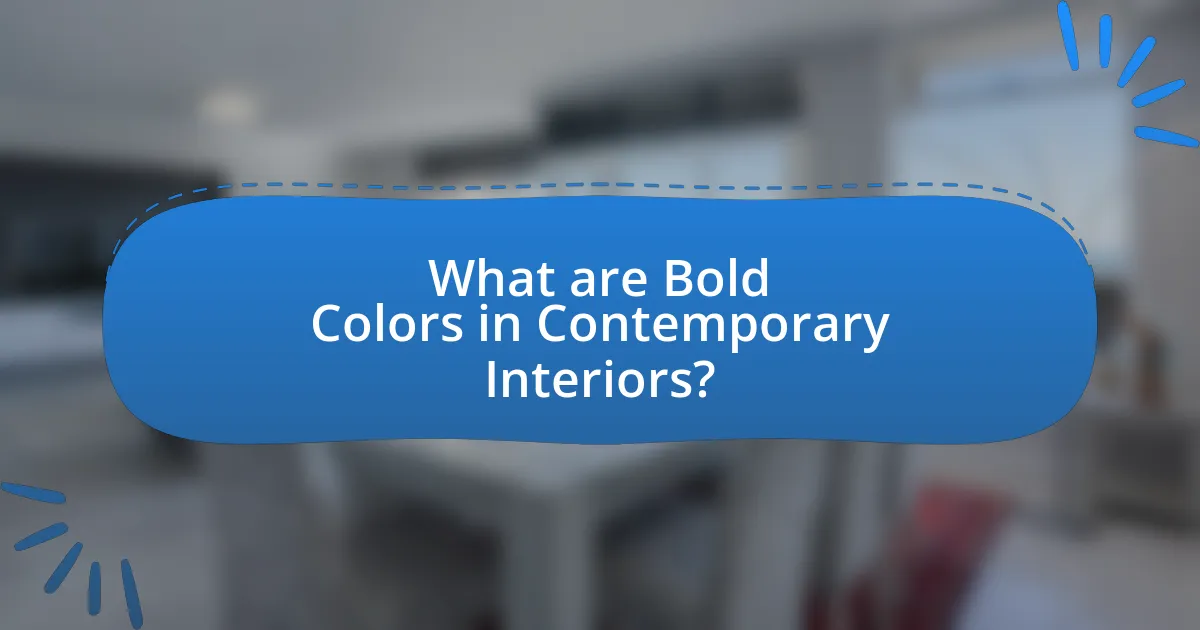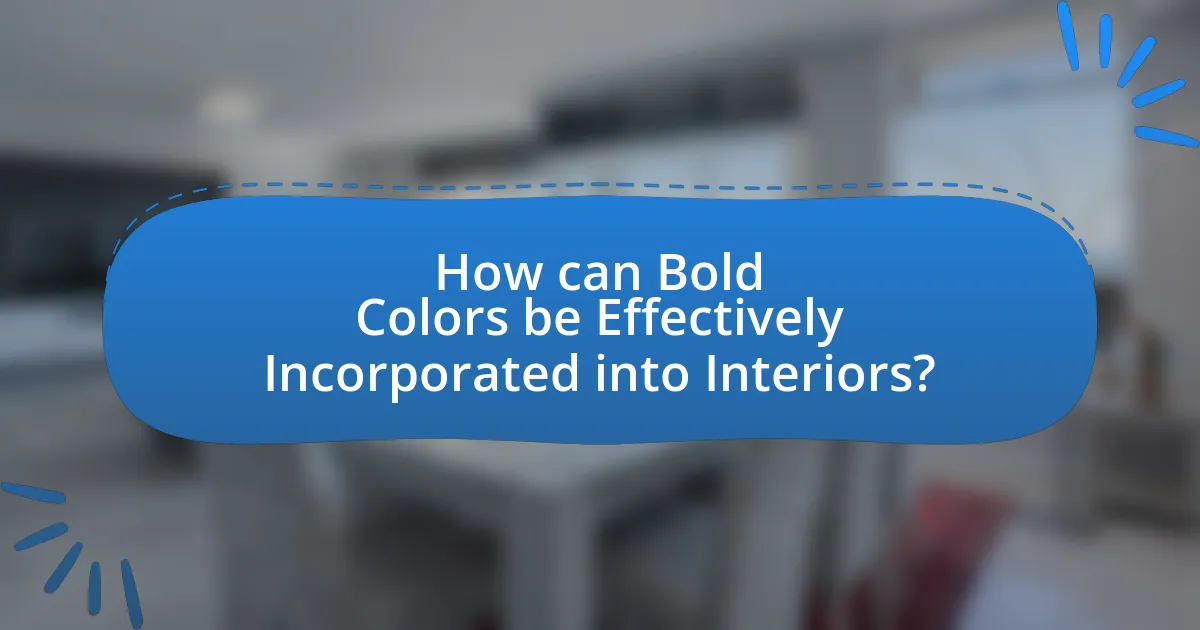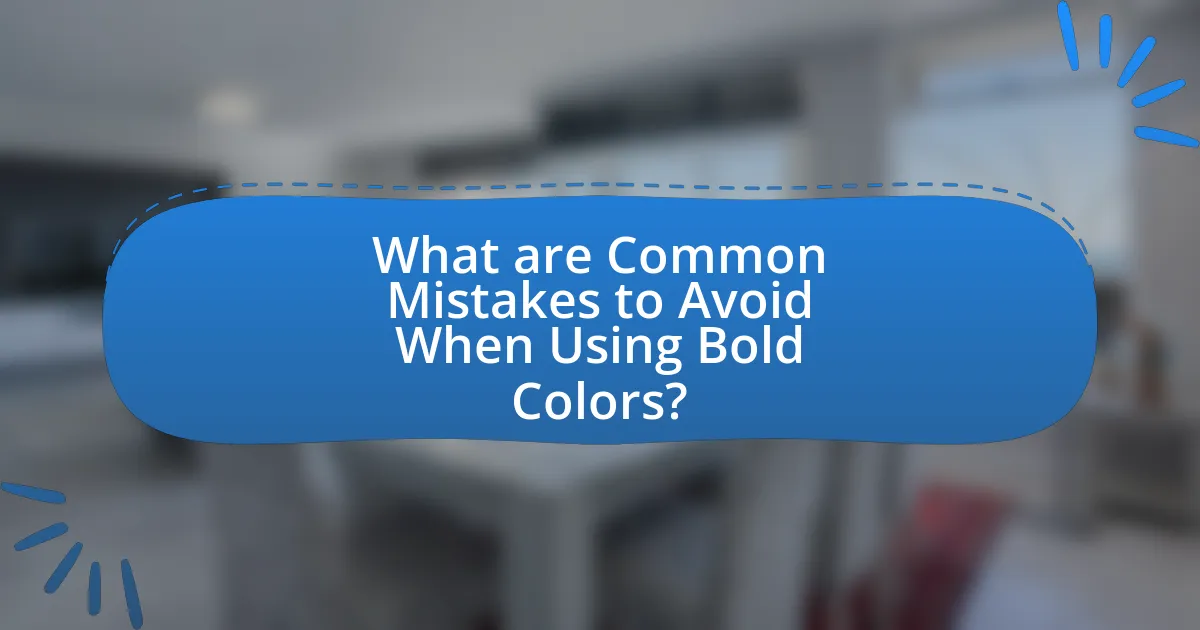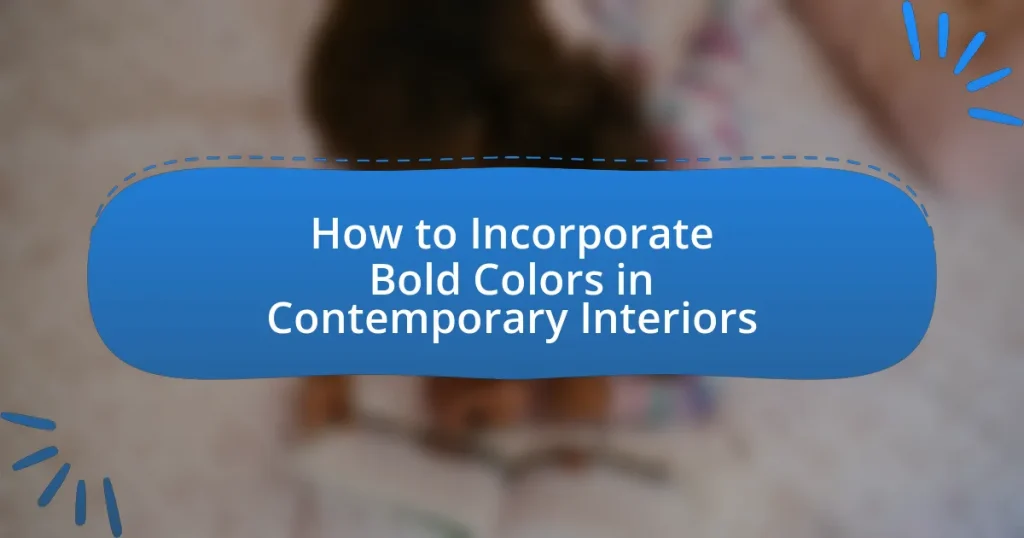The article focuses on the effective incorporation of bold colors in contemporary interiors, highlighting their visual impact and psychological effects on occupants. It discusses how bold colors can enhance the aesthetic of a space, influence emotions, and interact with lighting. Key trends driving the popularity of bold colors, such as personalization and social media influence, are examined, along with best practices for selecting and balancing these colors with neutrals. Additionally, the article addresses common mistakes to avoid and provides practical tips for achieving harmony in bold color applications within modern design.

What are Bold Colors in Contemporary Interiors?
Bold colors in contemporary interiors refer to vibrant, saturated hues that create a striking visual impact within a space. These colors, such as deep blues, bright reds, and vivid yellows, are often used to make a statement, enhance mood, and add personality to modern design. The use of bold colors can transform a room, drawing attention to specific areas or features, and they are frequently employed in accent walls, furniture, and decor items to create contrast and interest. Studies in color psychology indicate that bold colors can influence emotions and perceptions, making them a powerful tool in interior design.
How do bold colors influence the overall aesthetic of a space?
Bold colors significantly enhance the overall aesthetic of a space by creating visual impact and establishing emotional connections. These vibrant hues can energize a room, draw attention to specific areas, and influence the mood of the occupants. For instance, studies in color psychology indicate that warm colors like red and orange can evoke feelings of warmth and excitement, while cool colors like blue and green can promote calmness and relaxation. The strategic use of bold colors can also define spaces, making them feel more dynamic and inviting. In contemporary interiors, incorporating bold colors through accent walls, furniture, or decor can transform a bland environment into a lively and engaging atmosphere, thereby enhancing the overall design and functionality of the space.
What psychological effects do bold colors have on occupants?
Bold colors significantly influence the psychological state of occupants by evoking strong emotional responses. For instance, red can increase energy levels and stimulate excitement, while blue tends to promote calmness and tranquility. Research indicates that colors like yellow can enhance mood and creativity, whereas green is associated with balance and harmony. These effects are supported by studies in color psychology, such as those conducted by Andrew Elliot and Markus Maier, which demonstrate that color can affect cognitive performance and emotional well-being. Thus, the choice of bold colors in interior design can strategically enhance the atmosphere and emotional experience of a space.
How do bold colors interact with natural and artificial lighting?
Bold colors interact with natural and artificial lighting by significantly altering their appearance and intensity. Under natural light, bold colors can appear more vibrant and saturated, as sunlight enhances their hues, creating a lively atmosphere. Conversely, artificial lighting, depending on its type (such as incandescent, fluorescent, or LED), can either amplify or mute the vibrancy of bold colors. For example, incandescent lighting tends to warm colors, making them appear richer, while fluorescent lighting can create a cooler tone, potentially dulling the color’s impact. Studies have shown that the color temperature of light sources affects color perception; warmer lights enhance reds and yellows, while cooler lights emphasize blues and greens. This interaction is crucial for interior design, as it influences how bold colors are perceived in different settings.
Why are bold colors becoming popular in contemporary interior design?
Bold colors are becoming popular in contemporary interior design due to their ability to create striking visual impact and evoke emotional responses. Designers increasingly recognize that bold hues can energize spaces, enhance mood, and reflect personal style, making them appealing choices for homeowners. According to a survey by the American Society of Interior Designers, 70% of designers reported a rise in client requests for vibrant color schemes, indicating a shift towards more expressive and individualized interiors. This trend aligns with the broader cultural movement favoring authenticity and self-expression in personal spaces.
What trends are driving the use of bold colors in modern homes?
The trends driving the use of bold colors in modern homes include a growing preference for personalization, the influence of social media, and a shift towards maximalism in design. Personalization allows homeowners to express their individuality through vibrant color choices, moving away from neutral palettes. Social media platforms, particularly Instagram and Pinterest, showcase bold color schemes, inspiring homeowners to adopt similar aesthetics. Additionally, the maximalist trend encourages the use of rich, saturated colors as a counter to minimalist design, promoting a more eclectic and expressive interior style. These trends reflect a broader cultural shift towards embracing creativity and self-expression in home decor.
How do cultural influences shape the use of bold colors in interiors?
Cultural influences significantly shape the use of bold colors in interiors by dictating aesthetic preferences, symbolism, and emotional responses associated with color. For instance, in many African cultures, vibrant colors are used to express identity and community, often reflecting the natural environment and cultural heritage. In contrast, Scandinavian design typically favors muted tones, emphasizing simplicity and functionality, which can lead to a more restrained use of bold colors. Additionally, studies show that colors like red and yellow are often associated with warmth and hospitality in Mediterranean cultures, influencing their prevalence in interior design. This cultural context informs not only the choice of colors but also how they are combined and applied within spaces, demonstrating the profound impact of cultural backgrounds on interior color schemes.

How can Bold Colors be Effectively Incorporated into Interiors?
Bold colors can be effectively incorporated into interiors by using them as accent elements, such as in furniture, artwork, or decorative accessories. This approach allows for a striking visual impact without overwhelming the space. For instance, a study by the American Society of Interior Designers found that using bold colors in small doses can enhance mood and energy levels in a room, making it feel more vibrant and inviting. Additionally, pairing bold colors with neutral tones can create a balanced aesthetic, ensuring that the space remains cohesive and visually appealing.
What are the best practices for selecting bold colors for a space?
The best practices for selecting bold colors for a space include understanding the room’s purpose, considering natural light, and using color theory principles. First, identifying the function of the space helps determine the appropriate mood; for example, vibrant colors can energize a workspace, while deeper tones may create a calming atmosphere in a bedroom. Second, assessing the amount of natural light influences how colors appear; bold colors may look different in bright versus dim lighting, so testing samples in situ is essential. Lastly, applying color theory, such as complementary and analogous color schemes, ensures that bold colors harmonize with existing elements in the room. These practices are supported by design principles that emphasize the psychological impact of color and its interaction with light, which can significantly affect the overall aesthetic and functionality of a space.
How do you choose a color palette that includes bold colors?
To choose a color palette that includes bold colors, start by selecting a few dominant bold hues that resonate with the desired mood or theme of the space. For instance, colors like deep blue, vibrant red, or bright yellow can serve as focal points. Next, balance these bold colors with neutral shades such as white, gray, or beige to prevent overwhelming the space. This approach is supported by color theory, which emphasizes that bold colors can energize a room when paired with softer tones, creating visual harmony. Additionally, using tools like color wheels or digital design software can help visualize combinations and ensure that the chosen palette is cohesive and appealing.
What role does color theory play in selecting bold colors?
Color theory plays a crucial role in selecting bold colors by providing a framework for understanding how colors interact and influence perception. This framework includes concepts such as the color wheel, complementary colors, and color harmony, which guide designers in creating visually striking combinations. For instance, using complementary colors—colors opposite each other on the color wheel—can enhance the vibrancy of bold colors, making them stand out more effectively in contemporary interiors. Research indicates that color combinations can evoke specific emotions and responses; for example, bold reds and yellows can stimulate energy and excitement, while blues and greens can promote calmness. Thus, applying color theory not only aids in aesthetic choices but also in achieving desired emotional impacts within a space.
How can bold colors be balanced with neutral tones?
Bold colors can be balanced with neutral tones by using the 60-30-10 rule, where 60% of the space is dedicated to neutral colors, 30% to bold colors, and 10% to accent colors. This approach ensures that bold colors do not overwhelm the space, allowing them to stand out while being grounded by the calming effect of neutral tones. For instance, a bright red sofa can be complemented by beige walls and gray accessories, creating a harmonious look. This method is widely recognized in interior design, as it helps maintain visual interest without sacrificing balance.
What techniques can be used to create harmony between bold and neutral colors?
To create harmony between bold and neutral colors, one effective technique is to use a balanced color palette that incorporates varying shades and tints of both types. This approach allows bold colors to stand out without overwhelming the space, while neutral colors provide a calming backdrop. For instance, pairing a vibrant blue with lighter shades of gray can create a cohesive look. Additionally, employing the 60-30-10 rule, where 60% of the space is neutral, 30% is bold, and 10% is an accent color, helps maintain visual balance. This technique is supported by color theory, which emphasizes the importance of proportion in achieving aesthetic harmony.
How do accents and accessories enhance bold color schemes?
Accents and accessories enhance bold color schemes by providing contrast and depth, which can balance the intensity of the primary colors. For instance, using neutral or complementary tones in accessories can soften the visual impact of bold hues, creating a more harmonious environment. Research indicates that color theory supports this approach; for example, the use of contrasting colors can stimulate visual interest and engagement, making spaces feel more dynamic. Additionally, accessories like artwork, textiles, and decorative items can introduce texture and layers, further enriching the overall aesthetic while allowing bold colors to stand out without overwhelming the space.

What are Common Mistakes to Avoid When Using Bold Colors?
Common mistakes to avoid when using bold colors include overusing them, which can overwhelm a space, and failing to balance them with neutral tones, leading to visual chaos. Additionally, neglecting to consider the lighting can distort the color’s appearance, while not testing colors in the actual space may result in unexpected outcomes. Research indicates that color psychology plays a significant role in how colors affect mood and perception, emphasizing the importance of thoughtful application in design.
What pitfalls should be avoided when incorporating bold colors?
When incorporating bold colors, one should avoid overwhelming the space, as excessive use can create visual chaos. A balanced approach is essential; for instance, using bold colors as accents rather than dominant hues can maintain harmony. Additionally, neglecting to consider the lighting can lead to unexpected results, as natural and artificial light can alter the perception of color. Research indicates that color psychology plays a significant role in how spaces are perceived, with studies showing that certain colors can evoke specific emotions and responses. Therefore, understanding the emotional impact of bold colors is crucial to avoid creating an undesirable atmosphere.
How can overuse of bold colors negatively impact a space?
Overuse of bold colors can create a chaotic and overwhelming atmosphere in a space. When bold colors dominate, they can lead to visual fatigue, making it difficult for occupants to relax or focus. Research indicates that environments saturated with intense colors can increase stress levels and reduce overall comfort, as evidenced by a study published in the Journal of Environmental Psychology, which found that excessive bright colors can lead to heightened anxiety and distraction. Therefore, moderation is essential to maintain a balanced and harmonious interior.
What are the signs of poorly executed bold color schemes?
Signs of poorly executed bold color schemes include clashing colors, overwhelming visual noise, and lack of cohesion. Clashing colors occur when hues do not complement each other, leading to a jarring effect that distracts rather than enhances the space. Overwhelming visual noise arises when too many bold colors are used simultaneously, creating chaos and making it difficult for the eye to focus. Lack of cohesion is evident when bold colors are applied without a unifying theme or purpose, resulting in a disjointed appearance. These signs indicate that the color scheme fails to create a harmonious and inviting environment, which is essential in contemporary interior design.
How can you troubleshoot issues with bold color applications?
To troubleshoot issues with bold color applications, first assess the lighting conditions in the space, as inadequate or harsh lighting can distort color perception. Next, evaluate the color combinations used; clashing colors can create visual discomfort. Additionally, check the quality of the paint or materials, as low-quality products may not deliver the intended vibrancy or durability. Lastly, consider the scale and proportion of bold colors in relation to the overall design; overwhelming a small space with too much bold color can lead to a chaotic appearance. These steps are essential for achieving a harmonious and effective use of bold colors in contemporary interiors.
What adjustments can be made if a bold color feels overwhelming?
To mitigate the overwhelming effect of a bold color, one can incorporate neutral tones to balance the intensity. Neutral colors, such as whites, grays, or beiges, can soften the overall aesthetic and create a harmonious environment. For instance, a bold red accent wall can be complemented with light gray furniture and white decor elements, which helps to diffuse the visual impact of the red. Additionally, using bold colors in smaller doses, such as through accessories or artwork, rather than large surfaces, can also reduce their overwhelming presence while still allowing for vibrant expression in the space.
How can lighting changes improve the perception of bold colors?
Lighting changes can significantly enhance the perception of bold colors by altering their vibrancy and depth. Different light sources, such as natural daylight or artificial lighting, can affect how colors are seen; for instance, warm light can make bold colors appear richer and more inviting, while cool light can create a more dramatic effect. Studies show that the color temperature of light influences color perception, with warmer tones enhancing reds and yellows, making them appear more vivid, while cooler tones can enhance blues and greens. This phenomenon is supported by research from the Journal of the Optical Society of America, which indicates that lighting conditions can change the way colors are interpreted by the human eye, thereby affecting the overall aesthetic of a space.
What are some practical tips for incorporating bold colors in contemporary interiors?
To incorporate bold colors in contemporary interiors, start by selecting a focal point, such as an accent wall or a piece of furniture, to draw attention and create a vibrant atmosphere. This approach allows for a controlled use of bold colors without overwhelming the space. For instance, painting one wall in a deep blue or using a bright red sofa can serve as a striking centerpiece.
Additionally, balance bold colors with neutral tones to maintain harmony in the design. Using whites, grays, or beiges alongside bold hues can help to ground the space and prevent it from feeling chaotic. For example, pairing a vivid yellow chair with a soft gray backdrop can create a visually appealing contrast.
Incorporating accessories, such as cushions, artwork, or rugs, in bold colors can also enhance the overall aesthetic without committing to large-scale changes. This method allows for flexibility and easy updates to the color scheme. Research indicates that using bold colors can positively affect mood and perception of space, making it a beneficial choice in interior design.


